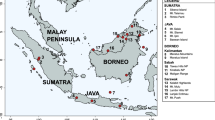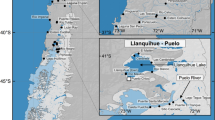Abstract
Controversy over the taxonomic designations within the genus Potorous has highlighted problems associated with using only morphological data. The recent rediscovery of Gilbert's Potoroo has allowed us to reexamine the relationship of this species to other extant potoroos. Phylogenetic relationships and estimated divergence times are presented, based on electrophoretic and cytochrome b sequence data. There was considerable concordance between the data sets. We conclude that Gilbert's Potoroo is a separate species and should be referred to by its original name, Potorous gilbertii (Gould 1841). Estimates for potoroid divergences are in line with those of Flannery (1989).
Similar content being viewed by others
LITERATURE CITED
Anderson, S., Bankier, A. T., Barrell, B. G., De Bruijn, M. H. L., Coulson, A. R., Drouin, J., Eperon, I. C., Nierlich, D. P., Roe, B. A., Sanger, F., Schreier, P. H., Smith, A. J. H., Staden, R., and Young, I. G. (1981). Sequence and organization of the human mitochondrial genome. Nature 290: 457–465.
Avise, J. C. (1989). A role for molecular genetics in the recognition and conservation of endangered species. Trends Ecol. Evol. 4: 279–281.
Avise, J. C., and Ball, M. (1990). Principles of genealogical concordance in species concepts and biological taxonomy. Oxford Surv. Evol. Biol. 7: 45–67.
Baverstock, P. R., Watts, C. H. S., and Cole, S. R. (1977). Electrophoretic comparisons between allopatric populations of five Australian pseudomyine rodents (Muridae). Aust. J. Biol. Sci. 30: 471–485.
Baynes, A., Merrilees, D., and Porter, J. K. (1975). Mammal remains from the upper levels of a late Pleistocene deposit in Devil's Lair, Western Australia. J. Roy. Soc. W.A. 58: 97–117.
Butler, H., and Merrilees, D. (1971). Remains of Potorous platyops (Marsupialia, Macropodidae) and other mammals from Bremer Bay, Western Australia. J. Roy. Soc. W.A. 54: 53–58.
Close, R. L., Murray, J. D., and Briscoe, D. A. (1990). Electrophoretic and chromosome surveys of the taxa of short-nosed bandicoots within the genus Isoodon. In: Bandicoots and Bilbies, J. H. Seebeck, P. R. Brown, R. L. Wallis, and C. M. Kemper, eds., pp. 19–27, Surrey Beatty & Sons, Sydney.
Cook, D. L. (1963). The fossil vertebrate fauna of Strongs Cave, Boranup, Western Australia. W.A. Nat. 8: 153–162.
Cracraft, J. (1983). Species concepts and speciation analysis. Curr. Ornith. 1: 159–187.
Farris, J. S. (1972). Estimating phylogenetic trees from distance matrices. Am. Nat. 106: 645–668.
Felsenstein, J. (1993). PHYLIP 3.5c (Phylogeny Inference Package), Department of Genetics, University of Washington, Seattle.
Fitch, W. M. (1991). Towards defining the course of evolution: Minimal changes for a specific tree topology. Syst. Zool. 20: 406–416.
Fitch, W. M., and Margoliash, E. (1967). Construction of phylogenetic trees. Science 155: 279–284.
Flannery, T. F. (1989). Phylogeny of the Macropoidea: A study in convergence. In: Kangaroos, Wallabies and Rat-kangaroos, G. Grigg, P. J. Jarman, and I. Hume, eds., pp. 1–46, Surrey Beatty & Sons, Sydney.
Irwin, D. M., Kocher, T. D., and Wilson, A. C. (1991). Evolution of cytochrome b gene in mammals. J. Mol. Evol. 32: 128–144.
Johnston, P. G., and Sharman, G. B. (1976). Studies on populations of Potorous Desmarest (Marsupialia) I. Morphological variation. Aust. J. Zool. 24: 573–588.
Johnston, P. G., and Sharman, G. B. (1977). Studies on populations of Potorous Desmarest (Marsupialia) II Electrophoretic, chromosomal and breeding studies. Aust. J. Zool. 25: 733–747.
Johnston, P. G., Davey, R. J., and Seebeck, J. H. (1984). Chromosome homologies in Potorous tridactylus and P. Longipes (Marsupialia: Macropodidae) based on G-banding patterns. Aust. J. Zool. 32: 319–324.
Kimura, M. (1980). A simple method for estimating evolutionary rate of base substitution through comparative study of nucleotide sequences. J. Mol. Evol. 16: 111–120.
King, M. (1993). Species Evolution: The Role of Chromosome Change, Cambridge University Press, Cambridge.
Krajewski, C., Painter, J., Driskell, A. C., Buckley, L., and Westerman, M. (1993). Molecular systematics of New Guinean dasyurids (Marsupialia: Dasyuridae). Sci. New Guinea. 19: 157–166.
Kumar, S., Tamura, K., and Nei, M. (1994). MEGA: Molecular Evolutionary Genetics Analysis, Version 1.01, Pennsylvania State University, University Park.
Mayr, E. (1963). Animal Species and Evolution, Harvard University Press, Cambridge, MA.
Merrilees, D. (1968). Man the destroyer: Late Quaternary changes in the Australian marsupial fauna. J. Roy. Soc. W.A. 51: 1–24.
Nei, M. (1978). Estimation of average heterozygosity and genetic distance from a small number of individuals. Genetics 89: 583–590.
Patton, J. L., Dos Reis, S. F., and Da Silva, M.-N. F. (1996). Relationships among didelphid marsupials based on sequence variation in the mitochondrial cytochrome b gene. J. Mammal. Evol. 3: 3–29.
Richardson, B. J., Baverstock, P. R., and Adams, M. (1986). Allozyme Electrophoresis: A Handbook for Animal Systematics and Population Studies, Academic Press, North Ryde.
Ride, W. D. L. (1970). A Guide to Native Mammals of Australia, Oxford University Press, Melbourne.
Rogers, J. S. (1972). Measures of genetic similarity and genetic distance. Stud. Genet. Univ. Texas Publ. 7312: 145–153.
Ryder, O. A. (1986). Species conservation and systematics: the dilemma of subspecies. Trends Ecol. Evol. 1: 9–10.
Saitou, N., and Nei, M. (1987). The neighbor-joining method: A new method for reconstruction of phylogenetic trees. Mol. Biol. Evol. 4: 406–425.
Sambrook, F., Fritsch, E. F., and Maniatis, T. (1989). Molecular Cloning: A Laboratory Manual, Cold Spring Harbor Laboratory, Cold Spring Harbor, NY.
Seebeck, J. H., and Johnston, J. G. (1980). Potorous longipes (Marsupialia: Macropodidae) a new species from eastern Victoria. Aust. J. Zool. 28: 119–134.
Seebeck, J. H., Bennett, A. F., and Scotts, D. J. (1989). Ecology of the Potoroidae—A review. In: Kangaroos, Wallabies and Rat-kangaroos, G. Grigg, P. J. Jarman, and I. Hume, eds., pp. 67–88, Surrey Beatty & Sons, Sydney.
Sherwin, W. B., and Murray, N. D. (1990). Population and conservation genetics of marsupials. Aust. J. Zool. 37: 161–180.
Sinclair, E. A., Danks, A., and Wayne, A. F. (1996). Rediscovery of Gilbert's potoroo, Potorous tridactylus, in Western Australia. Aust. Mammal. 19: 69–72.
Strahan, R. (1983). The Australian Museum Complete Book of Mammals, Angus and Robertson, Melbourne.
Strahan, R. (1995). The Mammals of Australia, Reed Books, Chatswood.
Swofford, D. L. (1993). PAUP: Phylogenetic Analysis Using Parsimony, Version 3.1.1, User's Manual, Illinois Natural History Survey, Champaign.
Swofford, D. L., and Selander, R. B. (1981). BIOSYS-1: A fortran program for the comprehensive analysis of electrophoretic data in population genetics and systematics. J. Hered. 72: 281–283.
Templeton, A. R. (1989). The meaning of species and speciation: A genetic perspective. In: Speciation and Its Consequences, D. Otte and J. A. Endler, eds., pp. 3–27, Sinauer Associates, Sunderland, MA.
Woodburne, M. O., MacFadden, B. J., Case, J. A., Springer, M., Pledge, N. S., Power, J. D., Woodburne, J. M., and Johnson, K. (1993). Land mammal biostratigraphy and magnetostratigraphy of the Etadunna Formation (late Oligocene) of South Australia. J. Vert. Paleontol. 13: 132–164.
Author information
Authors and Affiliations
Rights and permissions
About this article
Cite this article
Sinclair, E.A., Westerman, M. Phylogenetic Relationships Within the Genus Potorous (Marsupialia: Potoroidae) Based on Allozyme Electrophoresis and Sequence Analysis of the Cytochrome b Gene. Journal of Mammalian Evolution 4, 147–161 (1997). https://doi.org/10.1023/A:1027335907895
Issue Date:
DOI: https://doi.org/10.1023/A:1027335907895




